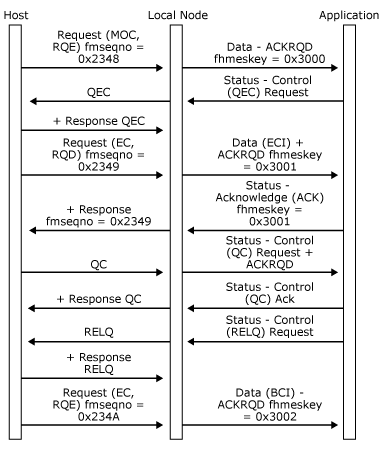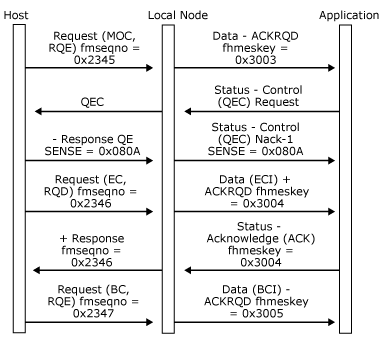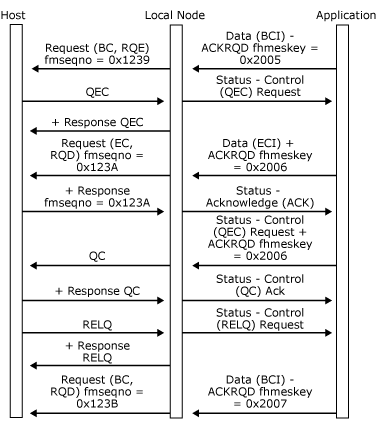Quiesce
The quiesce protocol is only supported on sessions using function management (FM) profile 4. The quiesce protocol can be initiated by either half-session.
When an application wants to quiesce its partner half-session in the host, it sends a Status-Control(QEC) Request to the local node. The node generates a QEC request to the host, which asks the host to quiesce after completing the current outbound chain.
If the host quiesces, it sends a QC request, which the local node presents to the application as a Status-Control(QC) Request (with ACKRQD). The host remains in a quiesced state until the application sends a Status-Control(RELQ) Request. The local node sends the RELQ request to the host, and the host resumes communications on the primary logical unit (PLU) session.
If the attempt to quiesce the host fails, the host responds with a negative QEC response, which the local node presents to the application as a Status-Control(QEC) Negative-Acknowledge-1.
Conversely, a Status-Control(QEC) Request (without ACKRQD) is presented to the application if a QEC request is received from the host. In this direction, QEC cannot be rejected. The local node will always force the application to quiesce after presenting it with a Status-Control(QEC) Request by rejecting further attempts to send inbound data. When the application has quiesced, it should send a Status-Control(QC) Request to the local node, which sends a QC request to the host. The application can subsequently be released by an RELQ request from the host, which the local node presents to the application as a Status-Control(RELQ) Request.
The receipt of a CLEAR or UNBIND–BIND sequence, Close(PLU)–Open(PLU), causes the quiesced state to be released.
The following three figures illustrate the quiesce protocols between the local node and the application and how those protocols relate to the underlying SNA protocols.
In the first figure, the application quiesces the host and then releases the quiesce.

Application quiesces the host and releases the quiesce
In the following figure, the application attempts to quiesce the host, but the host rejects the quiesce and continues with the next chain.

Application attempts to quiesce the host, but the host rejects and continues with the next chain
In the following figure, the host sends QEC while the application is sending a chain. The application completes the chain and sends a Status-Control(QC) Request. The host releases the quiesce by sending RELQ, and the local node sends a Status-Control(RELQ) Request to the application, which then initiates a new chain.

Host sends QEC while the application is sending a chain
See Also
Opening the PLU Connection
PLU Session
Outbound Chaining
Inbound Chaining
Segment Delivery
Brackets
Direction
Pacing and Chunking
Confirmation and Rejection of Data]
Shutdown and Quiesce
Recovery
Application-Initiated Termination
LUSTATs]
Response Time Monitor Data